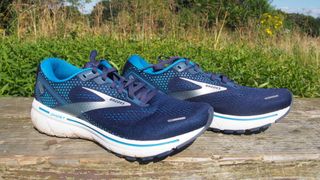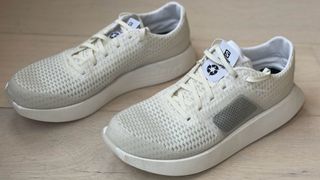
In today's ecologically-troubled times, choosing the best eco-friendly running shoes over standard trainers isn't just a swell idea – it's a must. Runners who care about the environment can and should pay attention to the carbon footprint of their gear. By choosing your next pair of trainers from the environmentally-friendly lot below, you can ensure you won't contribute to the planet's demise, or at the very least, your impact will be less severe.
It doesn't take much equipment to get into running, but a good pair of running shoes is one absolute necessity. Unfortunately, they don't last forever – particularly if you're putting in a lot of miles – and due to the degradation of the foam, shoes will need replacing once you hit the 3-400-mile mark. And that's just the foam; other parts of the shoes, such as the upper or the outsole, can wear away even sooner.
That could mean you go through shoes pretty quickly if you're running most days, so it makes sense to look for a pair with minimal environmental effects – but it's not a simple choice. There are many factors to consider, including the raw materials the shoes are made from and the processing necessary to turn those into something useful. Then there's the treatment of workers – are they paid a fair wage for their work and treated well? Finally, what happens to the shoe at the end of its life? Can it be recycled in any way, or is it destined for landfill?
Here we've rounded up our pick of the best eco-friendly running shoes available today. None is perfectly green, but if you're looking to reduce your carbon footprint and make your running more ethical, they're an excellent place to start. We've factored in our own experience from testing the shoes and the manufacturer's rating on Good on You, which ranks companies based on their treatment of people and the environment.
The best eco-friendly running shoes
Why you can trust TechRadar

Specifications
Reasons to buy
Reasons to avoid
The Reebok Floatride Energy Grow is made from at least 50% plant-based materials, reducing the use of virgin plastic – but you wouldn't know that from looking at it. Unlike some 'green' running shoes, this one doesn't shout about its credentials; instead, Reebok has opted for a refreshingly retro design that goes as well with jeans as it does Lycra.
There's a moderate amount of (castor-bean based) cushioning, and in our tests, we found it easy to forget during training runs. It's not excessively cushioned and is quite flexible around the toe (particularly medially), which won't suit those with a tendency to overpronate, but is nicely responsive if your footstrike is neutral.
There's a lot to like about this shoe, which is also surprisingly light, leaving the similarly green but much weightier Allbirds Tree Dasher in the dust. We have some reservations about the durability of the gusset that secures the tongue to the inside, but the Floatride Energy Grow otherwise fared well after plenty of miles.
Good On You commends Reebok for its efforts to audit the working conditions of its suppliers, use sustainable materials, reduce its carbon emissions, and conduct research into the effect of microplastics.
Read our full Reebok Floatride Energy Grow review

Specifications
Reasons to buy
Reasons to avoid
If you're looking for an eco-friendly running shoe that you can also wear around town, the Allbirds Tree Dashers are well worth your consideration. The knitted upper is made from breathable eucalyptus fibers, and the midsole foam is made from sugarcane rather than the usual plastic. It takes a lot of processing to turn the raw materials into usable materials, but Allbirds works to reduce carbon emissions as much as possible and offset the remainder.
The Tree Dashers are heavier than most other neutral road shoes we've reviewed, but we found they provided plenty of support, particularly under the arch of the foot. The sugar-based midsole gave good stability, and its shape (thinning out towards the toe) provided plenty of spring on take-off.
Our only complaint about the fit was that the sock lining rubbed the back of our heel slightly, but your experience may well differ; we'd recommend trying a pair to see how you get on with them.
Good On You praises Allbirds for its use of sustainable materials and its efforts to reduce both water use and greenhouse gas emissions. However, it's criticized for not showing a code of conduct for its suppliers or that it ensures workers in its supply chain are paid a living wage.
Read our full Allbirds Tree Dasher review

Specifications
Reasons to buy
Reasons to avoid
If you're looking for an eco-friendly racing shoe, the On Cloudboom Echo could be just the ticket. It's built for speed, with an extremely lightweight and breathable upper made from recycled polyester, a double layer of 'CloudTec' cushioning pods in the midsole, and a carbon fiber-infused plate for extra spring.
Some runners may find the Cloudboom Echo a little too firm, and it's better suited to narrow feet. We'd recommend saving it for race days and track sessions rather than everyday training runs.
On is a small company and has yet to be rated by Good On You, but it's transparent about its work and its suppliers. It recently published a sustainability report describing its efforts to use more sustainable materials, reduce carbon emissions and water use, recycle worn-out shoes, and support workers' rights (including a code of conduct that all suppliers must sign that sets out rules regarding a basic living wage).
Read our full On Cloudboom Echo review

Specifications
Reasons to buy
Reasons to avoid
The Brooks Ghost 14 is a dependable workhorse for your regular training runs. It's not the most exciting eco-friendly shoe to look at, but it's very good at what it does: eating up the miles. It's durable and well-cushioned but still delivers a little snap at faster paces. We found the Ghost 14's toe box particularly roomy, making it well suited to runners with wider feet, though the upper's stretchy material accommodates all shapes and sizes well.
That upper contains a minimum of 13% recycled polyester, and Brooks says that it's created a carbon-neutral production process by analyzing its supply chain, reducing carbon as much as possible, and offsetting the remainder.
Good On You notes that a moderate proportion of the fabrics used by Brooks are certified by BlueSign, though there's no evidence of policies for reducing carbon emissions or water use. There's not much transparency about its supply chain either, though some of its suppliers are also BlueSign certified.
Read our full Brooks Ghost 14 review

Specifications
Reasons to buy
Reasons to avoid
The whole of the Salomon Index.01 is recyclable, and when you've run it into the ground, you can return it to Salomon to be transformed into other garments.
Of course, that would be little use if the Salomon Index.01 wasn't good quality, high-performance shoe – but thankfully, it is. It feels firmer than most daily runners, making it a better choice if you're looking for support, with a curved sole and unusual rear overhang that we found gave a welcome forward jolt of propulsion.
The upper is pleasantly breathable, and its understated design means it can shift easily between training sessions and running errands. We did find that the upper began to show dirt quite quickly, and the initial price is fairly steep, so it's worth considering the Reebok Floatride Energy Grow as a more affordable alternative.
Good On You notes that Salomon publishes little information about other efforts to reduce textile waste, though 45% of its fabrics are Bluesign certified. The company does audit some of its supply chain during the final stage of production, but according to Good On You, there's no sign that it ensures payment of a living wage or supports workers' rights such as collective bargaining.
Read our full Salomon Index.01 review
How we test the best eco-friendly running shoes
Testing the best eco-friendly running shoes is a very similar process to how we test the best running shoes. Of course, there is a lot of running involved, but in the case of environmentally-conscious shoes, we also do thorough research about the company to see if they live up to the green standards they communicate in their ads. 'Greenwashing' is everywhere nowadays, and sometimes it's hard to tell the difference between genuine efforts and pretence without looking into the details.
Is Nike an eco-friendly brand?
Good on You rates Nike's overall eco-efforts as It's a Start, meaning there is room for improvement both in terms of making manufacturing processes greener and especially paying all their employees a decent living wage. Nike is trying to introduce more environmentally-friendly fabrics such as Nike Forward in its portfolio, but what it really needs is to scale up the green efforts to the company level so it can have a real (positive) impact on the environment.
Get the best Black Friday deals direct to your inbox, plus news, reviews, and more.
Sign up to be the first to know about unmissable Black Friday deals on top tech, plus get all your favorite TechRadar content.

Cat is TechRadar's Homes Editor specializing in kitchen appliances and smart home technology. She's been a tech journalist for 15 years, and is here to help you choose the right devices for your home and do more with them. When not working she's a keen home baker, and makes a pretty mean macaron.